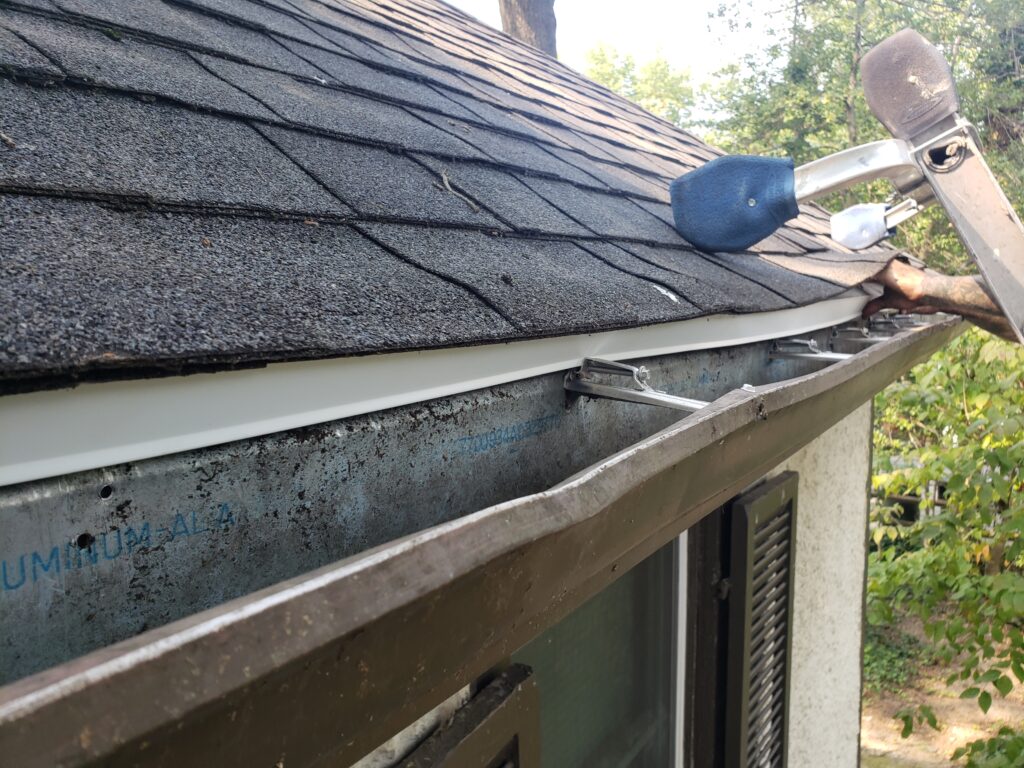
Bees In Fascia Boards
December 5, 2022
Gutters Leaking At Seams
December 20, 2022GUTTERS LEAKING FROM BEHIND
Do you have gutters leaking from behind? The water could be causing damages to your fascia boards.
In this article we will go over the possible causes of water coming from behind the gutters, and the solution to each problem.
CAUSES OF WATER BEHIND GUTTERS
Water can leak or overflow from the gutters for several reasons. Clogs in the gutters or downspouts are the most common cause of water to leak from the gutters. However, when the water goes behind the gutters it sometimes is an indication of other issues. If you have observed water going behind the gutters or down your fascia boards then this article is for you.
GUTTERS CLOGGED/DOWNSPOUT CLOGS
Leaves and other debris that lands on your roof ends up in the gutter system. If not cleaned out then eventually the water is going to wash the leaves into the downspouts. When leaves or other debris become stuck in the downspouts they form a blockage called a clog. Since the water is not able to drain through the downspout it will leak and overflow wherever it can.
As we previously mentioned clogs in the gutter system are the most common cause of gutters to leak. Clogs are easy to identify for homeowners and likely the cheapest fix out of the other options we’re discussing. Therefore it is important to confirm if the gutter system is clogged or not before investigating into other issues.

Water Leaks From Clogged Downspout
LEAKING NEAR THE DOWNSOUTS
Clogs in the downspout can cause water to leak over the fronts of the gutters, behind the gutters, or even from the downspouts. So water leaking is not a confirmation that the downspouts are clogged. However when you see water leaking or overflow the gutters near the downspouts, that is an indication that the downspout is likely clogged.

Water Leaking From Gutter Near The Downspout Indicates Clogs
WEAK FLOW FROM DOWNSPOUT
Another indication of clogs in downspouts are when very little water comes out of the downspout during rain. All of the downspouts around the home should have equal flow of water coming through them. If no water is flowing out of one downspout then that downspout is clogged.
SOLUTION
The solution to clogged gutters or downspouts is to manually remove the debris from your gutters and downspouts, or to have a gutter cleaning service done by a professional.
LOOSE GUTTERS
The second most common cause of gutters leaking from behind and also the most common gutter repair is loose gutters. There are several types of mounting hardware for gutters such as gutter spikes, brackets, hangers, or even roof straps. All of them are designed to secure the gutter tight to the fascia board for as long as possible. However not all gutter hangers are created equal. Many older homes still have gutter spikes holding up their gutter systems. Gutter spike are pretty much a big nail that used to be used to hang gutters. The problem with them is that the hole in the wood wears out eventually and the spikes pull loose. It’s important to remember any type of gutter mount can easily come loose. Especially if the fascia board is rotten.

GAP BEHIND GUTTERS
Luckily for home owners loose gutters is one of the easiest gutter repairs to spot. There is often a gap behind the gutter that if you look up through you can see a thin strip of sky light between the gutter and the wall.
GUTTER SAGGING IN THE MIDDLE
Gutters become loose enough that they start to bog down or sag in the middle. This is often easily observable as the gutters should generally be straight. If the gutter has a “smile” shape then it is likely loose in the middle.
LEANING OR TILTED GUTTER
Gutters that are very loose will start to lean or tilt forward. A leaning gutter is the last stage of looseness before a gutter will fall off of the home. Furthermore tilted gutters are very easy to spot as they look like they are barely hanging on.

SOLUTION
The solution to gutters that are loose is to have them re-secured (re-mounted, re-hung, etc..) to the home using new hardware. We suggest styles that feature a threaded screw as they will last much longer. For more information on re-securing gutters please visit our Gutter Repair page.
DRIP EDGE ISSUES
Roof flashing or more commonly known as drip edge is installed along the edge of roof line to cover the gap between the roof shingles and the gutter. This prevents water from going behind the gutter and damaging the fascia boards and also going under the shingles. The problem with identifying drip edge issues is that somebody will need to ladder up and put eyes on the gutters and roofing eave. In the photo below you will see drip edge that is too short. As a result water is able to go behind the gutter.

This Drip Edge Does Not Cover The Gap Between The Roof Decking and Gutter
NO DRIP EDGE / MISSING

Drip edge is a necessity for most homes to protect the roof edge and fascia boards. Therefore missing drip edge is no good. Without drip edge water is able to pour behind the gutter or even directly into the roof or walls.

When There Is No Drip Edge Water Can Go Behind The Fascia Board
GUTTER INSTALLED OVER DRIP EDGE
Another common mistake we see with drip edge is when somebody installs the gutter over the drip edge. This results in the drip edge being tucked behind the gutter which allows the water to leak from behind the gutters.
The purpose of drip edge is to direct the water into the gutter so that it doesn’t damage any wood. However when the drip edge is tucked behind the gutter the water is directed to the fascia boards where it causes damages.
In the photo below you see a gutter that doesn’t quite have the drip edge tucked behind it. However the way the hangers have it pinned to the back of the gutter can cause the water to go behind the gutter if the back lip is lower than the bottom of the drip edge. We suggest to bend drip edge outwards to ensure water doesn’t go behind the gutters.

Drip Edge Tucked Behind Gutter Hangers
SOLUTION
The solution to missing drip edge is to have new drip edge installed to the areas that do not have any. When the gutters are installed over top of the drip edge then the entire gutter needs to be removed and re-installed 1-2 inches lower than previously. For more information on drip edge please visit our Roofing Repairs page.
GUTTER PITCH ISSUES
We mentioned earlier that downspout clogs will cause gutters to leak near the downspout locations. But what about when gutters leak away from the downspout?

Water Leaking Away From Downspout Indicates Pitch Issues
GUTTERS LEAK AWAY FROM DOWNSPOUT
Gutters are sloped or tilted so that the water easily drains towards the downspouts. This slope is referred to as “gutter pitch”. When gutters go out of pitch the water is not able to drain properly. This causes the water to fill the gutters and eventually overflow or leak in the end of the gutter away from the downspout. 95% of the time you see water leaking from the end of the gutter opposite from the downspout, then the gutter is out of pitch.
SOLUTION
The solution to gutters going out of pitch and leaking is to have the gutters pitched correctly. Most gutter companies call this service something like “Gutter Re-Pitching” or “Re-Pitch Gutter”. For more information on re-pitching gutters, please visit our Gutter Repairs page.
FASCIA BOARD ISSUES
Lastly we’ll wrap it up with loose fascia boards and fascia board rot. Either one of these issues are the end result of gutters leaking from behind. If gutters are left to hang loose for extended periods of times, or lets say there was no drip edge on the home, then water destroys the fascia boards. Eventually the fascia boards will either come loose or even begin to rot.

Loose Fascia Board Causes Gutter To Lean
LOOSE FASCIA BOARD
Fascia board coming loose are usually the end result of not fixing loose gutters or when there is no drip edge. Often times the roofing rafters will become soft when water is able to go under the shingles and into the roof. Since the fascia boards are mounted to the roofing rafters, they will become loose once they are soft. Loose fascia boards will lean from the home which makes the gutters also look like they are leaning. Loose fascia boards are often confused with loose gutters because most people don’t know what fascia boards are.

FASCIA BOARD ROT
Fascia board rot is also the end result of letting loose gutters or clogged gutters go for extended periods of time. Rotten fascia boards are not able to secure the weight of gutter systems that are filled with water. Therefore gutters will pull loose which allows water to pour behind the gutters even more.

Fascia Board Rot
SOLUTION
Loose fascia board that are still in good condition are usually able to be re-secured back to the existing rafters. However sometimes rafter repairs are necessary if there was water damage to the rafters. Damaged fascia boards need to be replaced. For most fascia board repairs the gutters need to be taken off of the wall, then re-installed once the wood repair is finished. For more information on fascia board repairs, please visit our Wood Repair page.
CONCLUSION
If you have gutters leaking from behind than it is important to find out the cause as soon as possible. Water that goes behind the gutters damages the fascia boards and roofing rafters, which are much more expensive repairs than simple gutter maintenance.

Fascia and Soffit Damage From Water Behind Gutter
NOW ON INSTAGRAM AND FACEBOOK
To check out high definition photos of work visit our INSTAGRAM or FACEBOOK pages. Unfortunately web page load speeds have not caught up with the size of today’s high resolution images. After more than a few photos on one page the page loads too slow.
Therefore we started uploading our recent job photos to Instagram and Facebook since they are both great resources for infinite photo storage with no loss of image quality.
Feel free to give us a follow on either app to keep an eye out for coupons and promotional offers.
NEW LOCATION
93 Monocacy Blvd. A-6
Frederick, MD 21701
301-820-3209
SEE WHAT OTHER EXPERTS ARE ALSO SAYING
Repair Leaky Gutters by This Old House
My Gutters Are Leaking From Behind by Terry’s Plumbing
Water Runs Behind Gutter by Gutter Works
Gutters or Roof Leaking by Brothers Gutters
Check out some of our other top articles!

Gutter Corner Leaking: Why Miters Leak and How To Fix

Does Flex Seal Work On Gutter Seams?
When To Clean Gutters In The Fall
Is Spring Gutter Cleaning Necessary
Vinyl Gutter Screens: Product Review






2 Comments
[…] Gutters Leaking From Behind by My Gutter Doctor […]
[…] Gutters Leaking From Behind by My Gutter Doctor […]